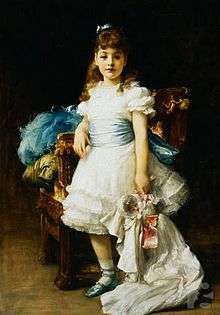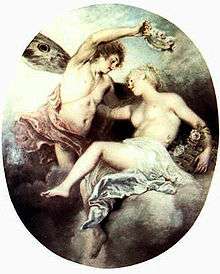Lady Sybil Grant

Lady Sybil Myra Caroline Grant (née Primrose; 1879–1955) was a British writer and artist.[1] She was the eldest child of Archibald Primrose, 5th Earl of Rosebery and his wife Hannah de Rothschild.
Apart from her artistic work, in later life she became notable as an eccentric.
Early years
Lady Sybil was the eldest child of Archibald Primrose, 5th Earl of Rosebery, who served as prime minister to Queen Victoria from 1894 to 1895, by his marriage to Hannah de Rothschild, only child of Mayer Amschel de Rothschild (1818–1874) and a granddaughter of Nathan Mayer Rothschild (1777–1836). Through Hannah, as her father's sole heiress, the Mentmore Towers estate passed into the Rosebery family.
Her father, Lord Rosebery, in addition to a life in Liberal politics and serving briefly as prime minister, collected Napoleonic memorabilia and wrote biographies, including one of Napoleon[2] and another of William Pitt the Younger.[3] Her mother, the Countess Hannah, was at one time reputed to be the richest woman in England. In her childhood Sybil was taught by governesses and divided her time between the family's Lansdowne House in London and their many country houses, which included Dalmeny House and Mentmore Towers. From the time she was a baby, Lady Sybil was often left by her parents in the care of servants, supervised by her father's sister Lady Leconfield at the Leconfields' Petworth House.[4] This was particularly evident shortly after Sybil's birth in June 1880, when Lord Rosebery wished to visit Germany for three months to take a cure at a German spa for what is now thought to have been a nervous breakdown.[5] He had no great feeling for proximity to small babies.[6] His wife dutifully accompanied him, but Rosebery reported that she savoured every detail of daily letters from London concerning Sybil.[7]
Despite the lack of parental attention, Lady Sybil remained close to her father.
Marriage
On 28 March 1903, at the Guards Chapel, Wellington Barracks, Lady Sybil married Charles John Cecil Grant (1877–1950), a regular soldier who later became a general and a Knight of the Bath. Following the wedding her father wrote: "She was wonderfully cool and held my hand all the way to the church".[8]
She had one son, Charles Robert Archibald Grant, who married Pamela Wellesley (born 1912), a granddaughter of Arthur, 4th Duke of Wellington.
Literary works

In 1912 Lady Sybil Grant published several short stories in the London Magazine, including The Kisses That Never Were Given, A Three-Cornered Secret, and Travesty.[9] In 1913 Mills and Boon published her Founded on Fiction, a book of comic poems. The same year The Chequer-Board appeared, followed by Samphire and The Land of Let's Pretend. In 1914, by now considered a literary figure, she was invited to contribute to Princess Mary's Gift Book, a collection of illustrated stories assembled to raise money for the Great War effort.
Lady Sybil was a patriotic admirer of the achievements of Marshal Foch, writing in a eulogy of him in 1929 that "the first impression you received was of an infinite horizon–he seemed to look beyond the common limits of human sight. When in the course of conversation he looked in your direction you felt the same helpless sense of inferiority as when, upon a night in deep summer, you look up at the stars."[10]
Inheritance
On the death of her father in 1929, she inherited one of his lesser estates, The Durdans at Epsom, which became her home. Among other things she inherited her father's extensive library at Durdans, much of which was sold at Sotheby's in 1933.
The arts and Bohemia
Some of Lady Sybil's designs were in ceramics,[11] where she drew for inspiration on her love of animals, particularly the Suffolk Punch horses which she bred. She had a great love of animals and succeeded in breeding a rare strain of dog, the Shetland Toy, which she may have saved from extinction.[12] In 1909 she became the first to breed the rare Pyrenean Mountain Dog in England, although examples had been imported earlier, including one owned by Queen Victoria in the 1850s.[13]
In 1937, Grant befriended the gypsies who regularly visited Epsom Downs during the Derby week, dressing herself in "unusual and romantic clothes."[14] She allowed them the use of her land, setting it aside every year for them, so that they had a legal place to camp, which had the result of halting some of the hostility between the local people and the gypsies.
With the Reverend Edward Dorling she was a leading supporter of the "Lest We Forget" charitable fund,[15] and on the charity's behalf she organised a fete in the grounds of The Durdans each year; here her pottery was often sold and in great demand.[11]
Later life and death
In later life Lady Sybil Grant became an eccentric, spending much of her time in a caravan[16] or up a tree, communicating with her butler through a megaphone. Widowed in 1950, she died in 1955 and was survived by her son.
On her death she donated 2,700 of the remaining books, pamphlets and manuscripts from her father's collections to the National Library of Scotland. The bequest included many memoirs and pamphlets on British and European history of the 18th and 19th centuries, including biographies of Pitt and Napoleon; an uncensored first edition of Baudelaire's Les Fleurs du Mal (Paris, 1857); maps, particularly of the area around Epsom; dictionaries of slang and cant; religious works, particularly relating to Cardinal Newman; and works on horseracing and field sports, including a complete run of the The Sporting Magazine from 1792 to 1870.[17]
Notes
- ↑ The National Register of Archives.
- ↑ Rosebery, Archibald Philip Primrose, 5th Earl of, Napoleon: The Last Phase (London: Humphreys, 1900)
- ↑ Rosebery, Archibald Philip Primrose, 5th Earl of, Life of Pitt (London: Macmillan & Co., 1891)
- ↑ Lady Constance Primrose married the second Baron Leconfield The peerage.com
- ↑ McKinstry p90
- ↑ McKinstry, p. 195
- ↑ McKinstry p. 78
- ↑ McKinstry p 461
- ↑ The Fiction Magazines Index
- ↑ Aston, p. 172
- 1 2 Ashtead Pottery for the Home.
- ↑ Shelties
- ↑ History of the Great Pyrenees
- ↑ Gypsies at the Epsom Derby
- ↑ Ashtead Pottery for the Home
- ↑ McKinstry
- ↑ Catalogue (D) of the National Library of Scotland.
References
- Aston, George (1932). The Biography of the Late Marshal Foch. New York: The Macmillan Company.
- McKinstry, Leo (2005). Rosebery, a statesman in turmoil. London: John Murray (publishers). ISBN 0-7195-6586-3.
- Young, Kenneth (1974). Harry, Lord Rosebery. London: Hodder and Stoughton. ISBN 0-340-16273-2.
External links
- Edwardian Modernists Photograph of Sybil Grant with other great contemporary literary figures
- Gypsies at the Epsom Derby
- Ashtead Pottery for the Home
- The Fiction Magazines Index
- Shelties
- The National Register of Archives
- Edwardian Modernists
- Lady Sybil biography
- Works by or about Lady Sybil Grant at Internet Archive
- Works by Lady Sybil Grant at LibriVox (public domain audiobooks)
